This is a pre 64 standard grade 1960 issue 300 H&H that I bought off a member here several years ago. The member just flips guns and I suspect he obtained it from an estate. The sights had been removed, the holes filled and completely reblued, this work had been excellently done. The stock however was not so well done. It had been stripped and sanded with the plastic butt plate removed which had rounded the crisp edge of the butt stock. The person had sanded over the checkering making Winchester's already not so good checkering even worse. I used the gun for a couple years as it was definitely operable and serviceable. I decided to give the stock a make over and make it look as close as I could to my Alaskan grade M-70 in 375 H&H. I had done the 375 over about 8 years ago adding a ebony tip and grip cap, recut the checkering and new finish. The 300 needed the same treatment plus a few more.
1960 vintage M-70's had plastic butt plates not the metal ones. The first year they eliminated the metal one I believe. So I acquired an original metal butt plate. I had to take 3/32" off the butt to get rid of the rounded edge, I then inlaid in the neider metal plate. Next I reshaped the area of the pistol grip to give it some definition so it could accept an ebony cap, next I cut off about 1 1/2" of the fore end, drilled the stock and ebony for two pieces of dowel and epoxied the dowels, ebony and stock all into one, plus I epoxied in place a slice of ebony for a grip cap. I shaped all that to look nice and made sure the barrel was free floated when in place. Pre 64 M 70's generally did not have stock cross bolts or reinforcement plugs in the two areas they are prone to cracking like the post 64 M 70's do. So while I was at it I decided it should have stock reinforcement plugs/dowels. So I drilled the stock to accept 3/8" ebony plugs, the interior hole that actually passes through the stock is 3/16"+. I epoxied 3/16" maple dowel and ebony plugs in each hole with each piece coming in contact with each other and a generous amount of expoxy. Shaped and sanded everything to look nice. Since I had come this far I thought I might as well glass bed the action as well so that I did that. Next I recut the checkering panels some areas of which were barely discernable. Last step was a new finish. There are several types of finishes I have used over the years all based on Tung and Linseed oil. I used Linspeed oil on the Alaskan so I used it on this 300 as well. When allowed to dry properly it gives a good finish which is easy to repair if need be. It takes several weeks to apply it and several months to get a good dry.
So anyways here are the results. It turned out rather well I think. Looks a hell of a lot better than it did anyways. I never took a before picture, should have. View attachment 368988 View attachment 368990View attachment 368991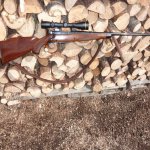

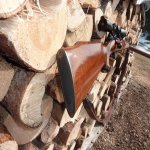
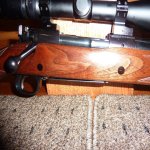
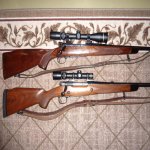
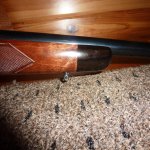
1960 vintage M-70's had plastic butt plates not the metal ones. The first year they eliminated the metal one I believe. So I acquired an original metal butt plate. I had to take 3/32" off the butt to get rid of the rounded edge, I then inlaid in the neider metal plate. Next I reshaped the area of the pistol grip to give it some definition so it could accept an ebony cap, next I cut off about 1 1/2" of the fore end, drilled the stock and ebony for two pieces of dowel and epoxied the dowels, ebony and stock all into one, plus I epoxied in place a slice of ebony for a grip cap. I shaped all that to look nice and made sure the barrel was free floated when in place. Pre 64 M 70's generally did not have stock cross bolts or reinforcement plugs in the two areas they are prone to cracking like the post 64 M 70's do. So while I was at it I decided it should have stock reinforcement plugs/dowels. So I drilled the stock to accept 3/8" ebony plugs, the interior hole that actually passes through the stock is 3/16"+. I epoxied 3/16" maple dowel and ebony plugs in each hole with each piece coming in contact with each other and a generous amount of expoxy. Shaped and sanded everything to look nice. Since I had come this far I thought I might as well glass bed the action as well so that I did that. Next I recut the checkering panels some areas of which were barely discernable. Last step was a new finish. There are several types of finishes I have used over the years all based on Tung and Linseed oil. I used Linspeed oil on the Alaskan so I used it on this 300 as well. When allowed to dry properly it gives a good finish which is easy to repair if need be. It takes several weeks to apply it and several months to get a good dry.
So anyways here are the results. It turned out rather well I think. Looks a hell of a lot better than it did anyways. I never took a before picture, should have. View attachment 368988 View attachment 368990View attachment 368991






Attachments
Last edited:













































































